Business Strategy Report: Innovation, Change, and Amazon Analysis
VerifiedAdded on 2023/05/31
|7
|1788
|479
Report
AI Summary
This report delves into the crucial intersection of innovation and change within the context of business strategy, emphasizing the need for organizations to adapt to the dynamic modern business environment. It begins by identifying current strategic business issues and industry trends, using Amazon (New Zealand) as a case study to highlight challenges in inventory management and supply chain optimization. The report then evaluates key approaches for managing innovation capabilities, emphasizing the importance of organizational renewal. Finally, it recommends change models, such as lateral marketing and Blue Ocean strategy, to support the implementation of innovation and business strategies. The conclusion underscores the importance of innovation and change for achieving and maintaining a competitive edge in the rapidly evolving business landscape, especially within the e-commerce sector.
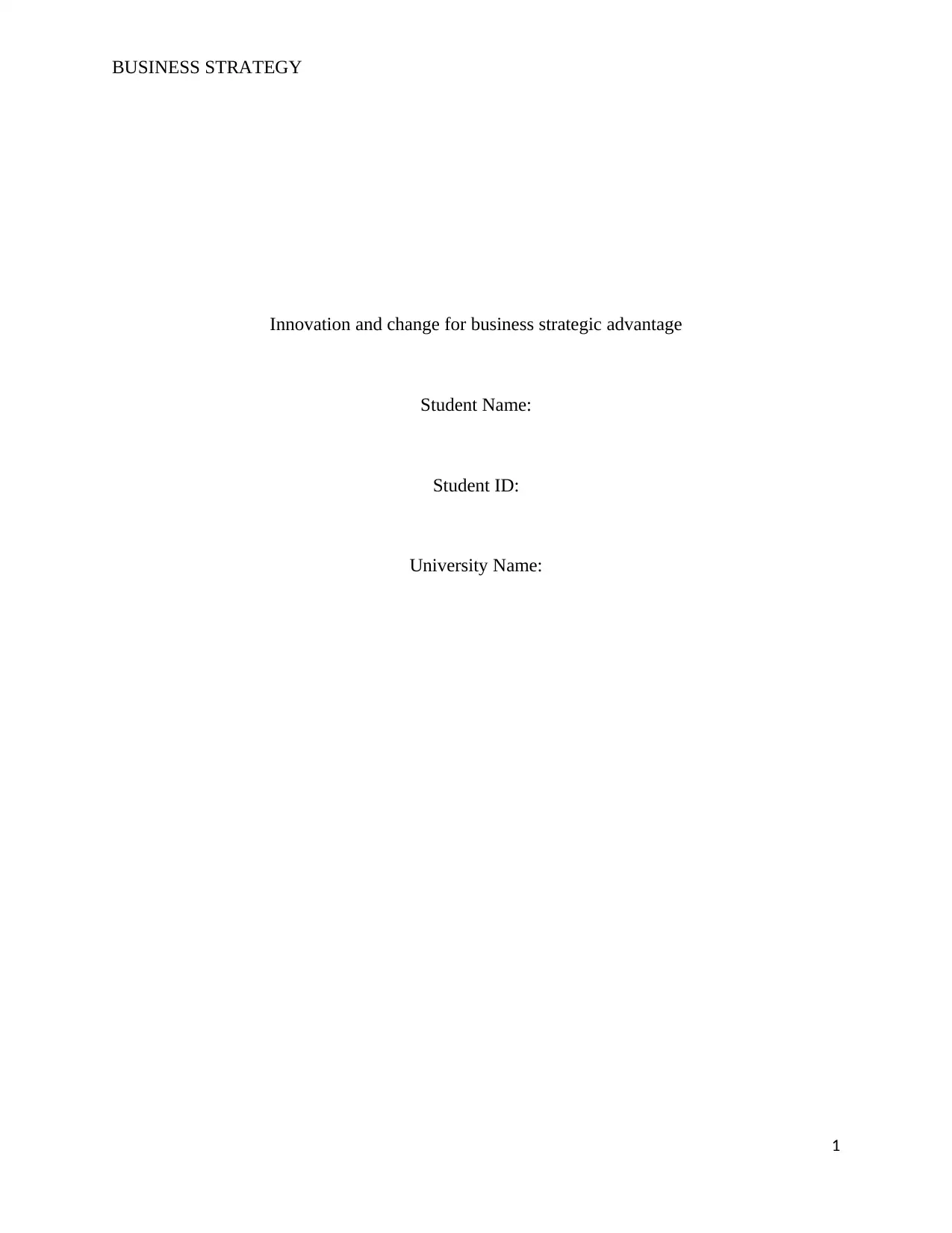
BUSINESS STRATEGY
Innovation and change for business strategic advantage
Student Name:
Student ID:
University Name:
1
Innovation and change for business strategic advantage
Student Name:
Student ID:
University Name:
1
Paraphrase This Document
Need a fresh take? Get an instant paraphrase of this document with our AI Paraphraser
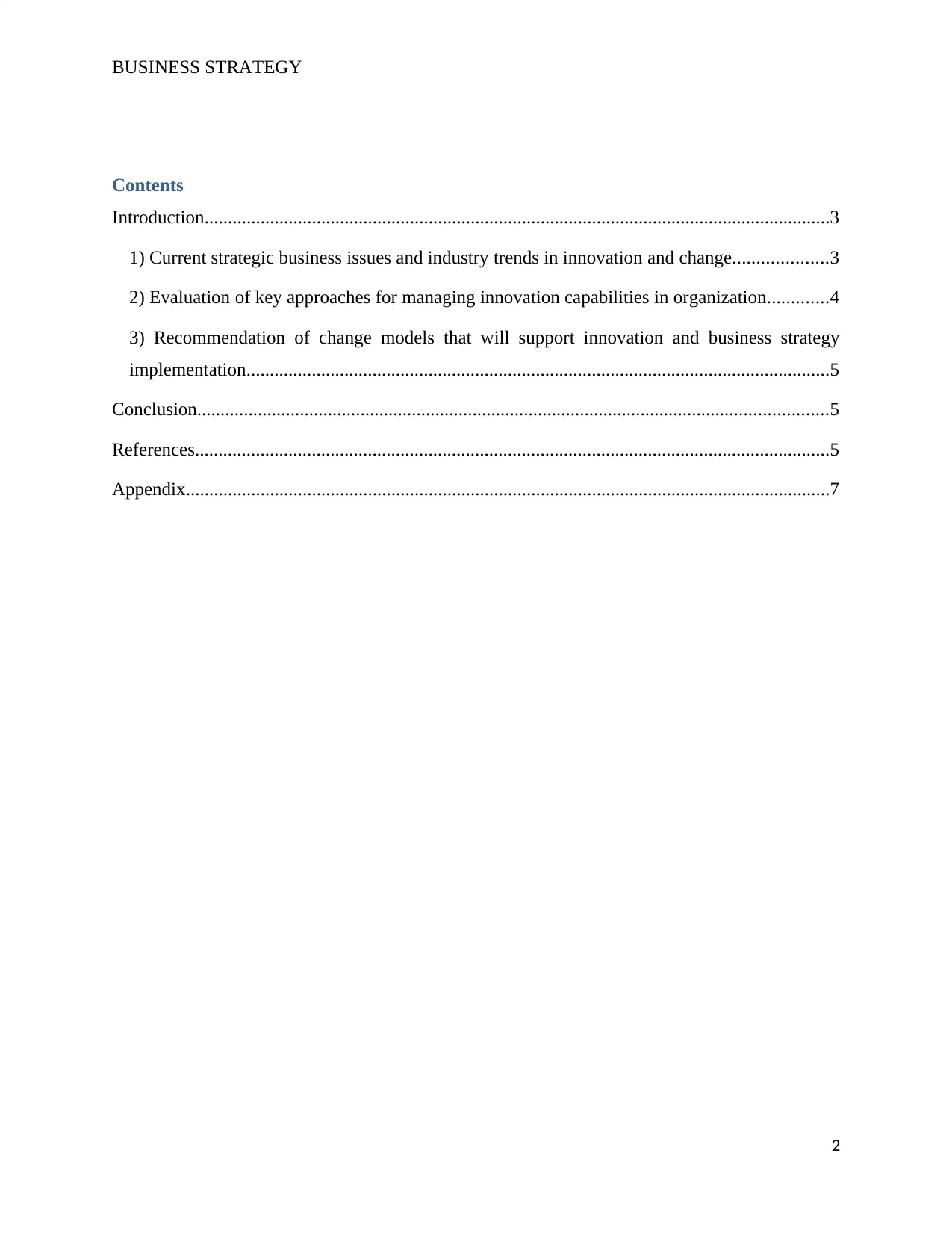
BUSINESS STRATEGY
Contents
Introduction......................................................................................................................................3
1) Current strategic business issues and industry trends in innovation and change....................3
2) Evaluation of key approaches for managing innovation capabilities in organization.............4
3) Recommendation of change models that will support innovation and business strategy
implementation.............................................................................................................................5
Conclusion.......................................................................................................................................5
References........................................................................................................................................5
Appendix..........................................................................................................................................7
2
Contents
Introduction......................................................................................................................................3
1) Current strategic business issues and industry trends in innovation and change....................3
2) Evaluation of key approaches for managing innovation capabilities in organization.............4
3) Recommendation of change models that will support innovation and business strategy
implementation.............................................................................................................................5
Conclusion.......................................................................................................................................5
References........................................................................................................................................5
Appendix..........................................................................................................................................7
2
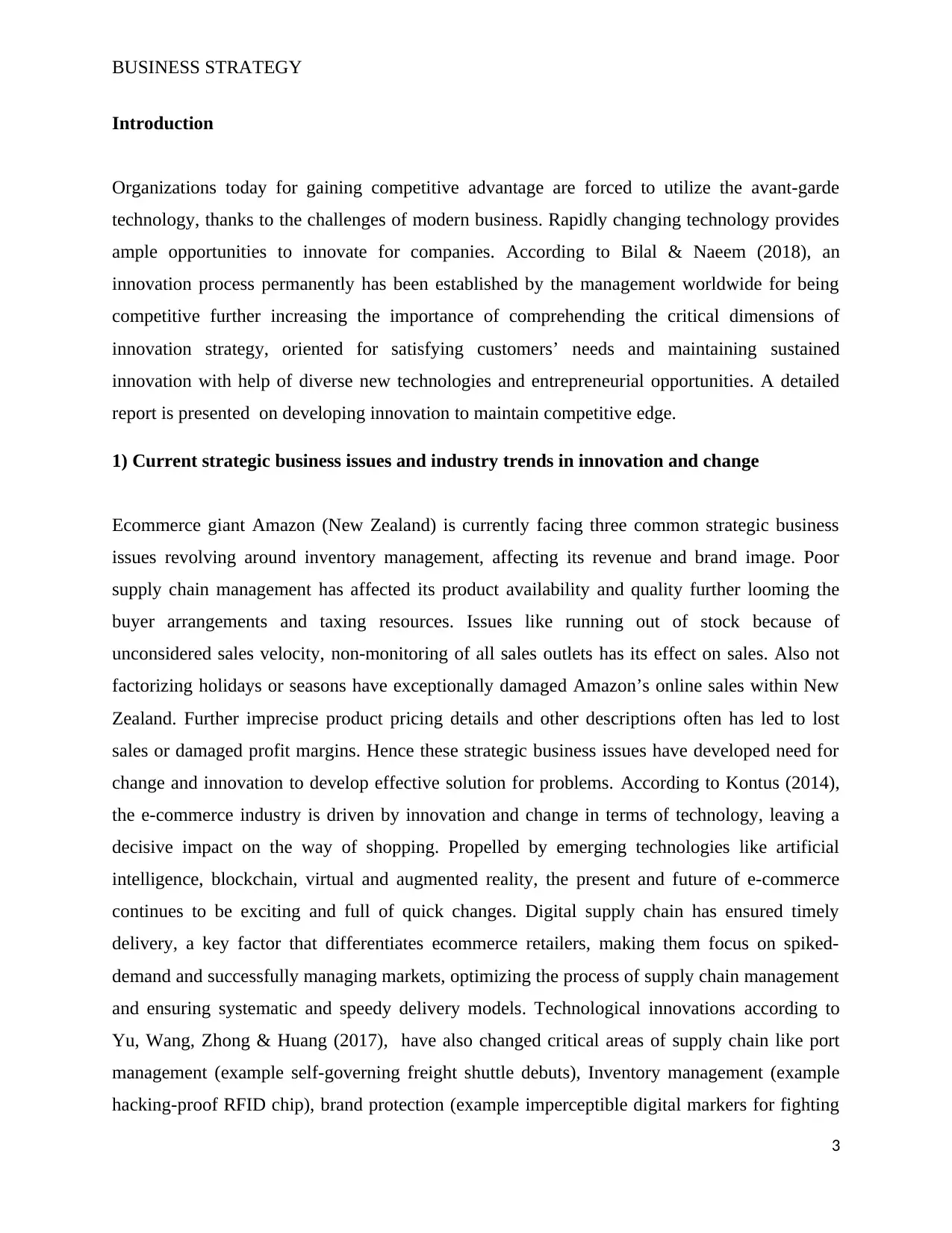
BUSINESS STRATEGY
Introduction
Organizations today for gaining competitive advantage are forced to utilize the avant-garde
technology, thanks to the challenges of modern business. Rapidly changing technology provides
ample opportunities to innovate for companies. According to Bilal & Naeem (2018), an
innovation process permanently has been established by the management worldwide for being
competitive further increasing the importance of comprehending the critical dimensions of
innovation strategy, oriented for satisfying customers’ needs and maintaining sustained
innovation with help of diverse new technologies and entrepreneurial opportunities. A detailed
report is presented on developing innovation to maintain competitive edge.
1) Current strategic business issues and industry trends in innovation and change
Ecommerce giant Amazon (New Zealand) is currently facing three common strategic business
issues revolving around inventory management, affecting its revenue and brand image. Poor
supply chain management has affected its product availability and quality further looming the
buyer arrangements and taxing resources. Issues like running out of stock because of
unconsidered sales velocity, non-monitoring of all sales outlets has its effect on sales. Also not
factorizing holidays or seasons have exceptionally damaged Amazon’s online sales within New
Zealand. Further imprecise product pricing details and other descriptions often has led to lost
sales or damaged profit margins. Hence these strategic business issues have developed need for
change and innovation to develop effective solution for problems. According to Kontus (2014),
the e-commerce industry is driven by innovation and change in terms of technology, leaving a
decisive impact on the way of shopping. Propelled by emerging technologies like artificial
intelligence, blockchain, virtual and augmented reality, the present and future of e-commerce
continues to be exciting and full of quick changes. Digital supply chain has ensured timely
delivery, a key factor that differentiates ecommerce retailers, making them focus on spiked-
demand and successfully managing markets, optimizing the process of supply chain management
and ensuring systematic and speedy delivery models. Technological innovations according to
Yu, Wang, Zhong & Huang (2017), have also changed critical areas of supply chain like port
management (example self-governing freight shuttle debuts), Inventory management (example
hacking-proof RFID chip), brand protection (example imperceptible digital markers for fighting
3
Introduction
Organizations today for gaining competitive advantage are forced to utilize the avant-garde
technology, thanks to the challenges of modern business. Rapidly changing technology provides
ample opportunities to innovate for companies. According to Bilal & Naeem (2018), an
innovation process permanently has been established by the management worldwide for being
competitive further increasing the importance of comprehending the critical dimensions of
innovation strategy, oriented for satisfying customers’ needs and maintaining sustained
innovation with help of diverse new technologies and entrepreneurial opportunities. A detailed
report is presented on developing innovation to maintain competitive edge.
1) Current strategic business issues and industry trends in innovation and change
Ecommerce giant Amazon (New Zealand) is currently facing three common strategic business
issues revolving around inventory management, affecting its revenue and brand image. Poor
supply chain management has affected its product availability and quality further looming the
buyer arrangements and taxing resources. Issues like running out of stock because of
unconsidered sales velocity, non-monitoring of all sales outlets has its effect on sales. Also not
factorizing holidays or seasons have exceptionally damaged Amazon’s online sales within New
Zealand. Further imprecise product pricing details and other descriptions often has led to lost
sales or damaged profit margins. Hence these strategic business issues have developed need for
change and innovation to develop effective solution for problems. According to Kontus (2014),
the e-commerce industry is driven by innovation and change in terms of technology, leaving a
decisive impact on the way of shopping. Propelled by emerging technologies like artificial
intelligence, blockchain, virtual and augmented reality, the present and future of e-commerce
continues to be exciting and full of quick changes. Digital supply chain has ensured timely
delivery, a key factor that differentiates ecommerce retailers, making them focus on spiked-
demand and successfully managing markets, optimizing the process of supply chain management
and ensuring systematic and speedy delivery models. Technological innovations according to
Yu, Wang, Zhong & Huang (2017), have also changed critical areas of supply chain like port
management (example self-governing freight shuttle debuts), Inventory management (example
hacking-proof RFID chip), brand protection (example imperceptible digital markers for fighting
3
⊘ This is a preview!⊘
Do you want full access?
Subscribe today to unlock all pages.

Trusted by 1+ million students worldwide
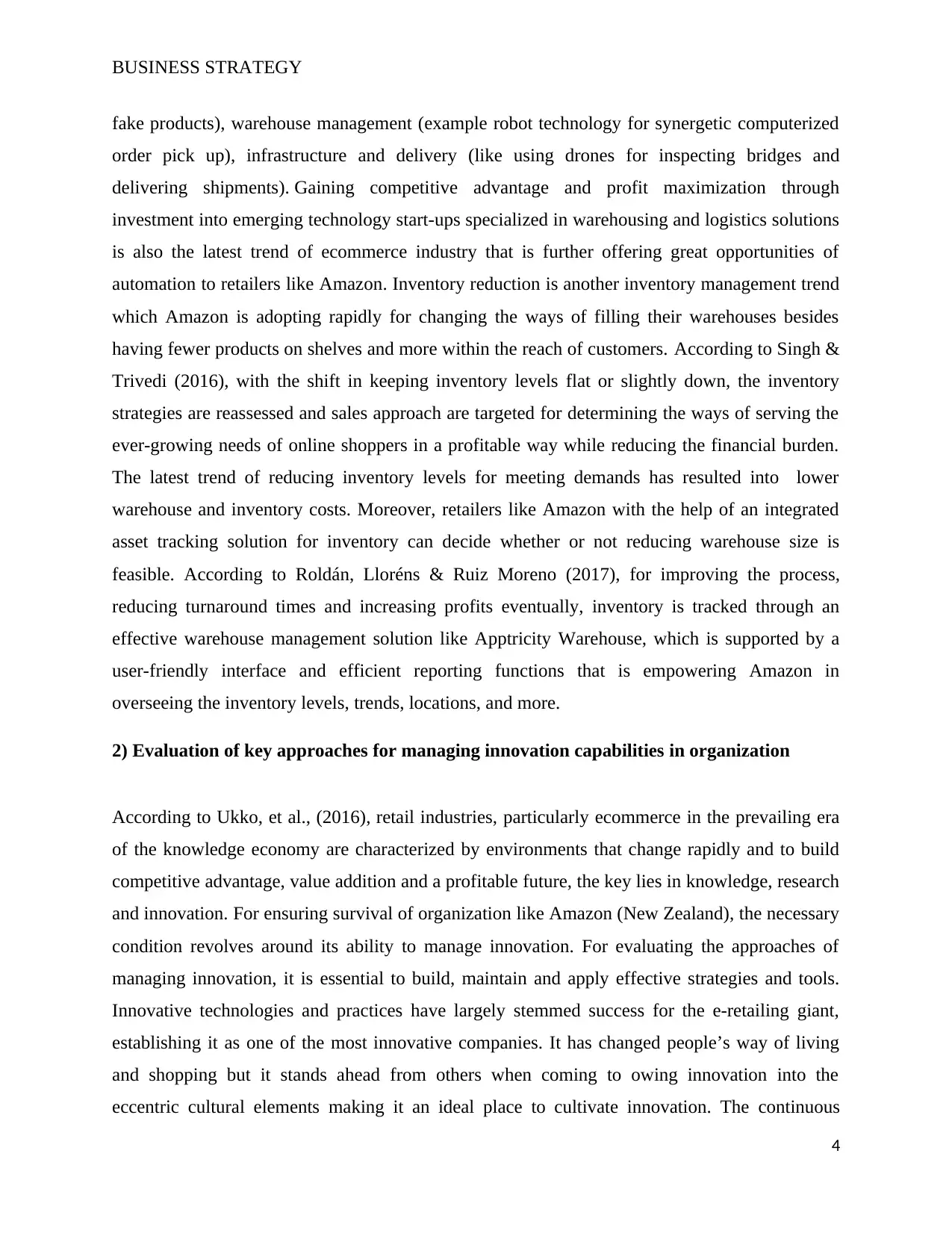
BUSINESS STRATEGY
fake products), warehouse management (example robot technology for synergetic computerized
order pick up), infrastructure and delivery (like using drones for inspecting bridges and
delivering shipments). Gaining competitive advantage and profit maximization through
investment into emerging technology start-ups specialized in warehousing and logistics solutions
is also the latest trend of ecommerce industry that is further offering great opportunities of
automation to retailers like Amazon. Inventory reduction is another inventory management trend
which Amazon is adopting rapidly for changing the ways of filling their warehouses besides
having fewer products on shelves and more within the reach of customers. According to Singh &
Trivedi (2016), with the shift in keeping inventory levels flat or slightly down, the inventory
strategies are reassessed and sales approach are targeted for determining the ways of serving the
ever-growing needs of online shoppers in a profitable way while reducing the financial burden.
The latest trend of reducing inventory levels for meeting demands has resulted into lower
warehouse and inventory costs. Moreover, retailers like Amazon with the help of an integrated
asset tracking solution for inventory can decide whether or not reducing warehouse size is
feasible. According to Roldán, Lloréns & Ruiz Moreno (2017), for improving the process,
reducing turnaround times and increasing profits eventually, inventory is tracked through an
effective warehouse management solution like Apptricity Warehouse, which is supported by a
user-friendly interface and efficient reporting functions that is empowering Amazon in
overseeing the inventory levels, trends, locations, and more.
2) Evaluation of key approaches for managing innovation capabilities in organization
According to Ukko, et al., (2016), retail industries, particularly ecommerce in the prevailing era
of the knowledge economy are characterized by environments that change rapidly and to build
competitive advantage, value addition and a profitable future, the key lies in knowledge, research
and innovation. For ensuring survival of organization like Amazon (New Zealand), the necessary
condition revolves around its ability to manage innovation. For evaluating the approaches of
managing innovation, it is essential to build, maintain and apply effective strategies and tools.
Innovative technologies and practices have largely stemmed success for the e-retailing giant,
establishing it as one of the most innovative companies. It has changed people’s way of living
and shopping but it stands ahead from others when coming to owing innovation into the
eccentric cultural elements making it an ideal place to cultivate innovation. The continuous
4
fake products), warehouse management (example robot technology for synergetic computerized
order pick up), infrastructure and delivery (like using drones for inspecting bridges and
delivering shipments). Gaining competitive advantage and profit maximization through
investment into emerging technology start-ups specialized in warehousing and logistics solutions
is also the latest trend of ecommerce industry that is further offering great opportunities of
automation to retailers like Amazon. Inventory reduction is another inventory management trend
which Amazon is adopting rapidly for changing the ways of filling their warehouses besides
having fewer products on shelves and more within the reach of customers. According to Singh &
Trivedi (2016), with the shift in keeping inventory levels flat or slightly down, the inventory
strategies are reassessed and sales approach are targeted for determining the ways of serving the
ever-growing needs of online shoppers in a profitable way while reducing the financial burden.
The latest trend of reducing inventory levels for meeting demands has resulted into lower
warehouse and inventory costs. Moreover, retailers like Amazon with the help of an integrated
asset tracking solution for inventory can decide whether or not reducing warehouse size is
feasible. According to Roldán, Lloréns & Ruiz Moreno (2017), for improving the process,
reducing turnaround times and increasing profits eventually, inventory is tracked through an
effective warehouse management solution like Apptricity Warehouse, which is supported by a
user-friendly interface and efficient reporting functions that is empowering Amazon in
overseeing the inventory levels, trends, locations, and more.
2) Evaluation of key approaches for managing innovation capabilities in organization
According to Ukko, et al., (2016), retail industries, particularly ecommerce in the prevailing era
of the knowledge economy are characterized by environments that change rapidly and to build
competitive advantage, value addition and a profitable future, the key lies in knowledge, research
and innovation. For ensuring survival of organization like Amazon (New Zealand), the necessary
condition revolves around its ability to manage innovation. For evaluating the approaches of
managing innovation, it is essential to build, maintain and apply effective strategies and tools.
Innovative technologies and practices have largely stemmed success for the e-retailing giant,
establishing it as one of the most innovative companies. It has changed people’s way of living
and shopping but it stands ahead from others when coming to owing innovation into the
eccentric cultural elements making it an ideal place to cultivate innovation. The continuous
4
Paraphrase This Document
Need a fresh take? Get an instant paraphrase of this document with our AI Paraphraser
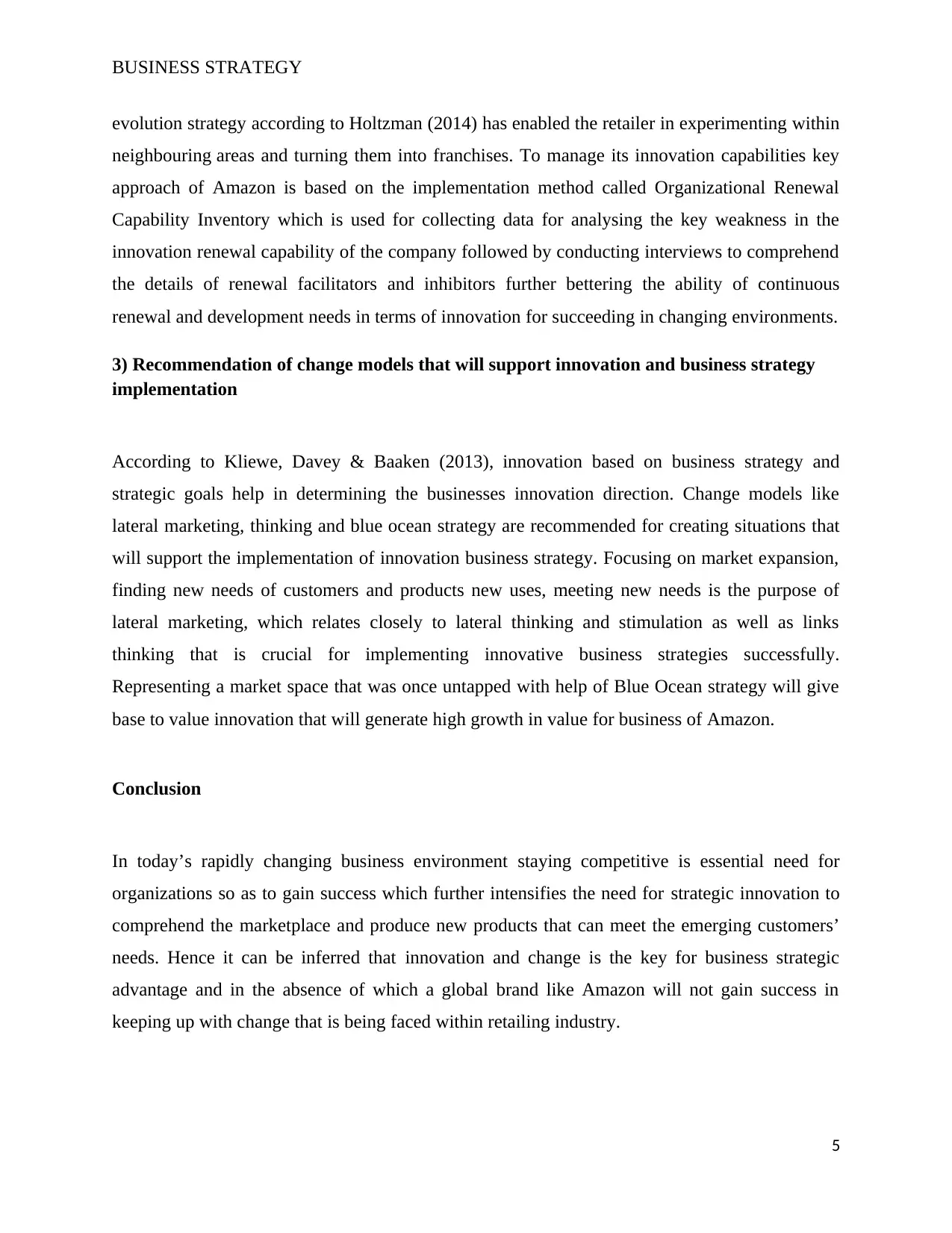
BUSINESS STRATEGY
evolution strategy according to Holtzman (2014) has enabled the retailer in experimenting within
neighbouring areas and turning them into franchises. To manage its innovation capabilities key
approach of Amazon is based on the implementation method called Organizational Renewal
Capability Inventory which is used for collecting data for analysing the key weakness in the
innovation renewal capability of the company followed by conducting interviews to comprehend
the details of renewal facilitators and inhibitors further bettering the ability of continuous
renewal and development needs in terms of innovation for succeeding in changing environments.
3) Recommendation of change models that will support innovation and business strategy
implementation
According to Kliewe, Davey & Baaken (2013), innovation based on business strategy and
strategic goals help in determining the businesses innovation direction. Change models like
lateral marketing, thinking and blue ocean strategy are recommended for creating situations that
will support the implementation of innovation business strategy. Focusing on market expansion,
finding new needs of customers and products new uses, meeting new needs is the purpose of
lateral marketing, which relates closely to lateral thinking and stimulation as well as links
thinking that is crucial for implementing innovative business strategies successfully.
Representing a market space that was once untapped with help of Blue Ocean strategy will give
base to value innovation that will generate high growth in value for business of Amazon.
Conclusion
In today’s rapidly changing business environment staying competitive is essential need for
organizations so as to gain success which further intensifies the need for strategic innovation to
comprehend the marketplace and produce new products that can meet the emerging customers’
needs. Hence it can be inferred that innovation and change is the key for business strategic
advantage and in the absence of which a global brand like Amazon will not gain success in
keeping up with change that is being faced within retailing industry.
5
evolution strategy according to Holtzman (2014) has enabled the retailer in experimenting within
neighbouring areas and turning them into franchises. To manage its innovation capabilities key
approach of Amazon is based on the implementation method called Organizational Renewal
Capability Inventory which is used for collecting data for analysing the key weakness in the
innovation renewal capability of the company followed by conducting interviews to comprehend
the details of renewal facilitators and inhibitors further bettering the ability of continuous
renewal and development needs in terms of innovation for succeeding in changing environments.
3) Recommendation of change models that will support innovation and business strategy
implementation
According to Kliewe, Davey & Baaken (2013), innovation based on business strategy and
strategic goals help in determining the businesses innovation direction. Change models like
lateral marketing, thinking and blue ocean strategy are recommended for creating situations that
will support the implementation of innovation business strategy. Focusing on market expansion,
finding new needs of customers and products new uses, meeting new needs is the purpose of
lateral marketing, which relates closely to lateral thinking and stimulation as well as links
thinking that is crucial for implementing innovative business strategies successfully.
Representing a market space that was once untapped with help of Blue Ocean strategy will give
base to value innovation that will generate high growth in value for business of Amazon.
Conclusion
In today’s rapidly changing business environment staying competitive is essential need for
organizations so as to gain success which further intensifies the need for strategic innovation to
comprehend the marketplace and produce new products that can meet the emerging customers’
needs. Hence it can be inferred that innovation and change is the key for business strategic
advantage and in the absence of which a global brand like Amazon will not gain success in
keeping up with change that is being faced within retailing industry.
5
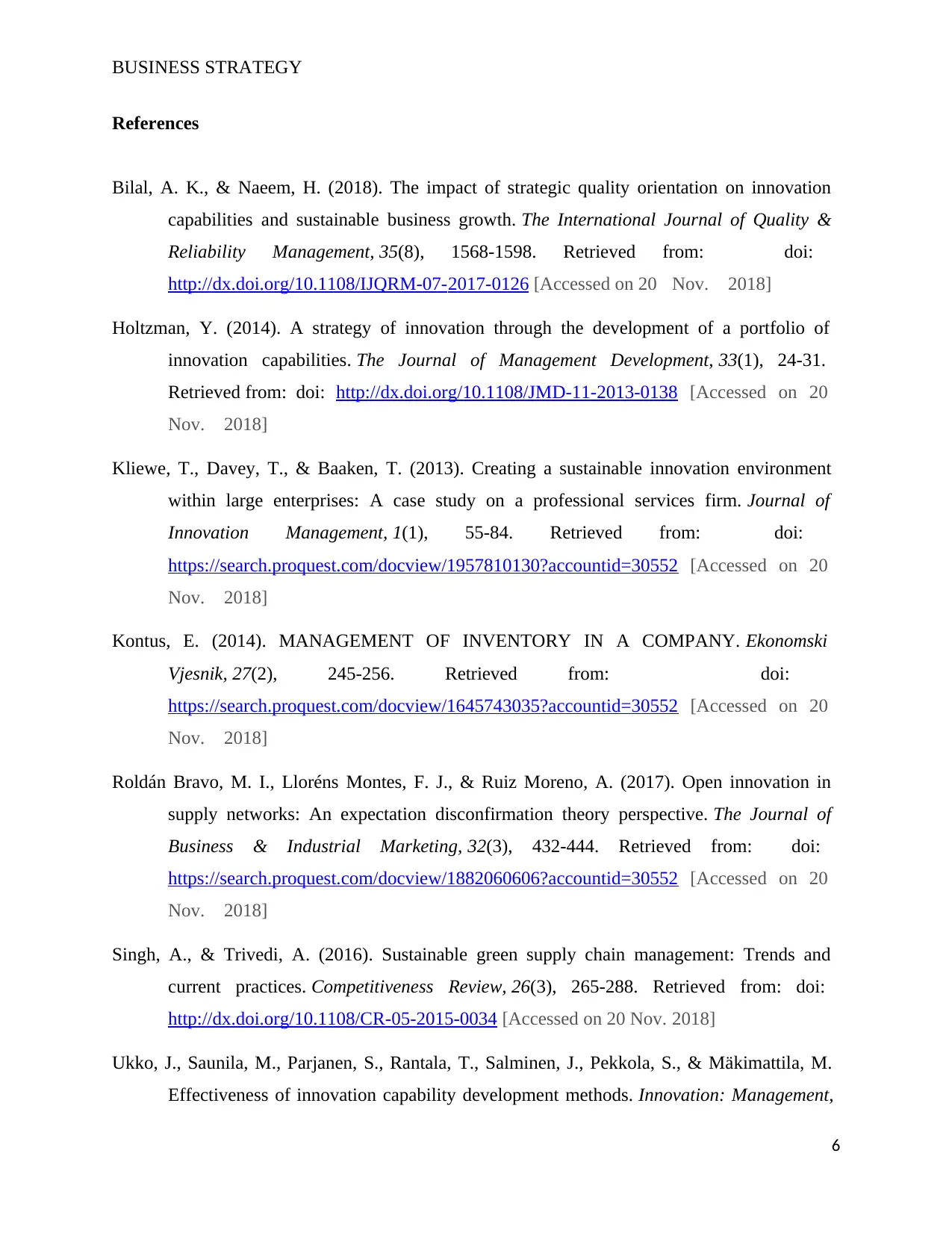
BUSINESS STRATEGY
References
Bilal, A. K., & Naeem, H. (2018). The impact of strategic quality orientation on innovation
capabilities and sustainable business growth. The International Journal of Quality &
Reliability Management, 35(8), 1568-1598. Retrieved from: doi:
http://dx.doi.org/10.1108/IJQRM-07-2017-0126 [Accessed on 20 Nov. 2018]
Holtzman, Y. (2014). A strategy of innovation through the development of a portfolio of
innovation capabilities. The Journal of Management Development, 33(1), 24-31.
Retrieved from: doi: http://dx.doi.org/10.1108/JMD-11-2013-0138 [Accessed on 20
Nov. 2018]
Kliewe, T., Davey, T., & Baaken, T. (2013). Creating a sustainable innovation environment
within large enterprises: A case study on a professional services firm. Journal of
Innovation Management, 1(1), 55-84. Retrieved from: doi:
https://search.proquest.com/docview/1957810130?accountid=30552 [Accessed on 20
Nov. 2018]
Kontus, E. (2014). MANAGEMENT OF INVENTORY IN A COMPANY. Ekonomski
Vjesnik, 27(2), 245-256. Retrieved from: doi:
https://search.proquest.com/docview/1645743035?accountid=30552 [Accessed on 20
Nov. 2018]
Roldán Bravo, M. I., Lloréns Montes, F. J., & Ruiz Moreno, A. (2017). Open innovation in
supply networks: An expectation disconfirmation theory perspective. The Journal of
Business & Industrial Marketing, 32(3), 432-444. Retrieved from: doi:
https://search.proquest.com/docview/1882060606?accountid=30552 [Accessed on 20
Nov. 2018]
Singh, A., & Trivedi, A. (2016). Sustainable green supply chain management: Trends and
current practices. Competitiveness Review, 26(3), 265-288. Retrieved from: doi:
http://dx.doi.org/10.1108/CR-05-2015-0034 [Accessed on 20 Nov. 2018]
Ukko, J., Saunila, M., Parjanen, S., Rantala, T., Salminen, J., Pekkola, S., & Mäkimattila, M.
Effectiveness of innovation capability development methods. Innovation: Management,
6
References
Bilal, A. K., & Naeem, H. (2018). The impact of strategic quality orientation on innovation
capabilities and sustainable business growth. The International Journal of Quality &
Reliability Management, 35(8), 1568-1598. Retrieved from: doi:
http://dx.doi.org/10.1108/IJQRM-07-2017-0126 [Accessed on 20 Nov. 2018]
Holtzman, Y. (2014). A strategy of innovation through the development of a portfolio of
innovation capabilities. The Journal of Management Development, 33(1), 24-31.
Retrieved from: doi: http://dx.doi.org/10.1108/JMD-11-2013-0138 [Accessed on 20
Nov. 2018]
Kliewe, T., Davey, T., & Baaken, T. (2013). Creating a sustainable innovation environment
within large enterprises: A case study on a professional services firm. Journal of
Innovation Management, 1(1), 55-84. Retrieved from: doi:
https://search.proquest.com/docview/1957810130?accountid=30552 [Accessed on 20
Nov. 2018]
Kontus, E. (2014). MANAGEMENT OF INVENTORY IN A COMPANY. Ekonomski
Vjesnik, 27(2), 245-256. Retrieved from: doi:
https://search.proquest.com/docview/1645743035?accountid=30552 [Accessed on 20
Nov. 2018]
Roldán Bravo, M. I., Lloréns Montes, F. J., & Ruiz Moreno, A. (2017). Open innovation in
supply networks: An expectation disconfirmation theory perspective. The Journal of
Business & Industrial Marketing, 32(3), 432-444. Retrieved from: doi:
https://search.proquest.com/docview/1882060606?accountid=30552 [Accessed on 20
Nov. 2018]
Singh, A., & Trivedi, A. (2016). Sustainable green supply chain management: Trends and
current practices. Competitiveness Review, 26(3), 265-288. Retrieved from: doi:
http://dx.doi.org/10.1108/CR-05-2015-0034 [Accessed on 20 Nov. 2018]
Ukko, J., Saunila, M., Parjanen, S., Rantala, T., Salminen, J., Pekkola, S., & Mäkimattila, M.
Effectiveness of innovation capability development methods. Innovation: Management,
6
⊘ This is a preview!⊘
Do you want full access?
Subscribe today to unlock all pages.

Trusted by 1+ million students worldwide
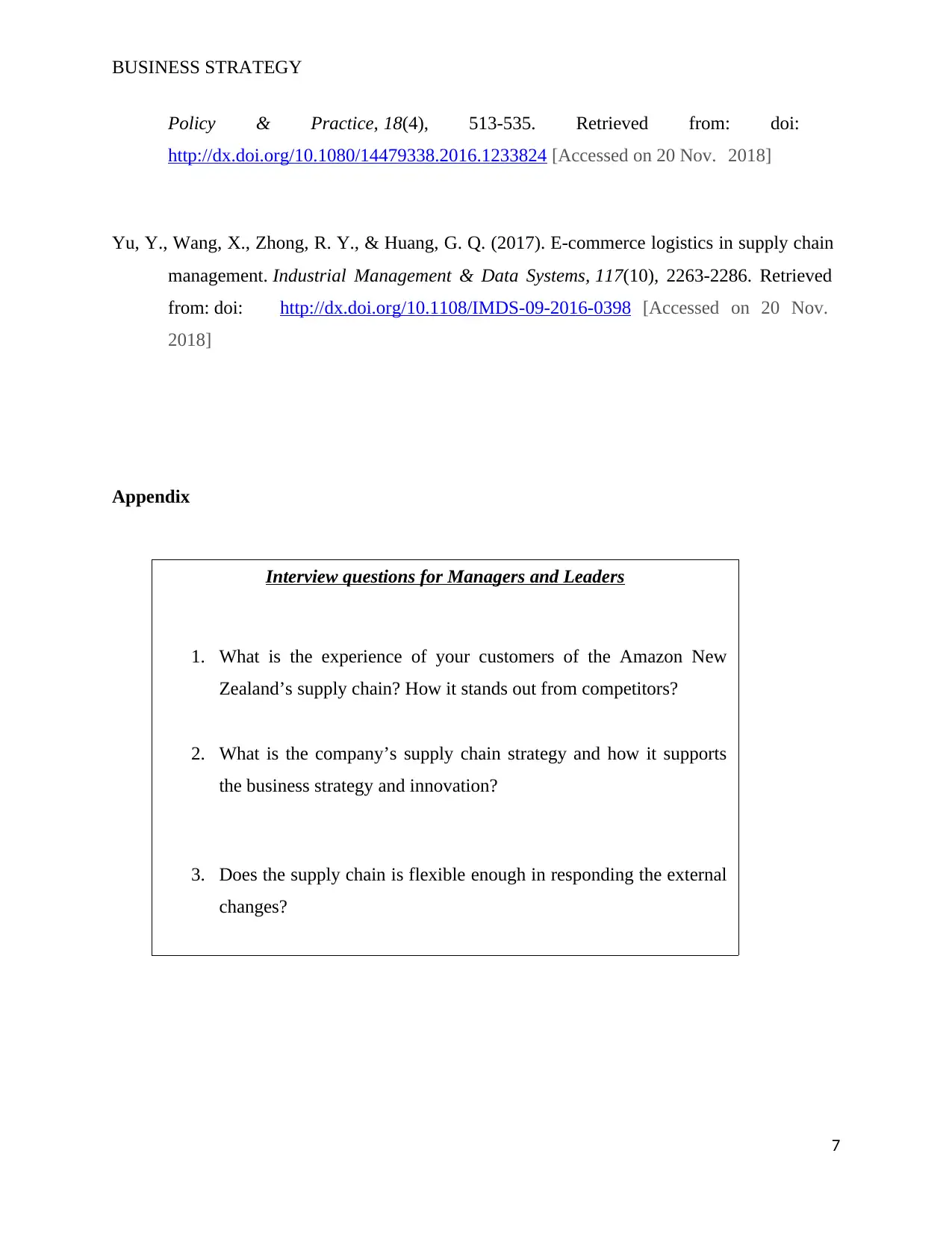
BUSINESS STRATEGY
Policy & Practice, 18(4), 513-535. Retrieved from: doi:
http://dx.doi.org/10.1080/14479338.2016.1233824 [Accessed on 20 Nov. 2018]
Yu, Y., Wang, X., Zhong, R. Y., & Huang, G. Q. (2017). E-commerce logistics in supply chain
management. Industrial Management & Data Systems, 117(10), 2263-2286. Retrieved
from: doi: http://dx.doi.org/10.1108/IMDS-09-2016-0398 [Accessed on 20 Nov.
2018]
Appendix
7
Interview questions for Managers and Leaders
1. What is the experience of your customers of the Amazon New
Zealand’s supply chain? How it stands out from competitors?
2. What is the company’s supply chain strategy and how it supports
the business strategy and innovation?
3. Does the supply chain is flexible enough in responding the external
changes?
Policy & Practice, 18(4), 513-535. Retrieved from: doi:
http://dx.doi.org/10.1080/14479338.2016.1233824 [Accessed on 20 Nov. 2018]
Yu, Y., Wang, X., Zhong, R. Y., & Huang, G. Q. (2017). E-commerce logistics in supply chain
management. Industrial Management & Data Systems, 117(10), 2263-2286. Retrieved
from: doi: http://dx.doi.org/10.1108/IMDS-09-2016-0398 [Accessed on 20 Nov.
2018]
Appendix
7
Interview questions for Managers and Leaders
1. What is the experience of your customers of the Amazon New
Zealand’s supply chain? How it stands out from competitors?
2. What is the company’s supply chain strategy and how it supports
the business strategy and innovation?
3. Does the supply chain is flexible enough in responding the external
changes?
1 out of 7
Related Documents
Your All-in-One AI-Powered Toolkit for Academic Success.
+13062052269
info@desklib.com
Available 24*7 on WhatsApp / Email
![[object Object]](/_next/static/media/star-bottom.7253800d.svg)
Unlock your academic potential
Copyright © 2020–2025 A2Z Services. All Rights Reserved. Developed and managed by ZUCOL.




